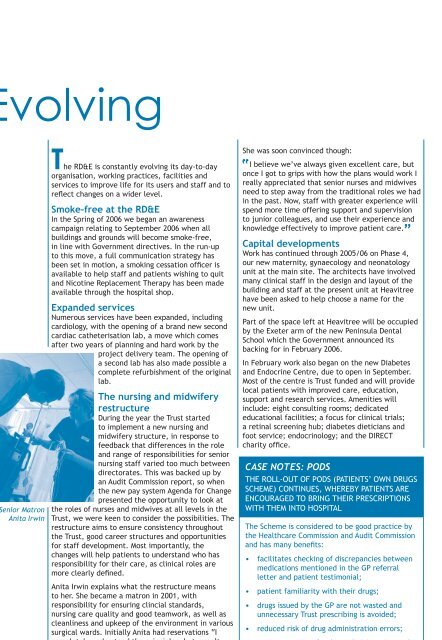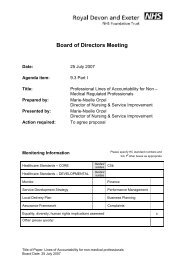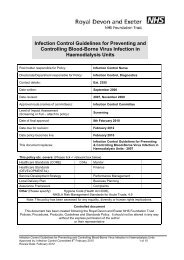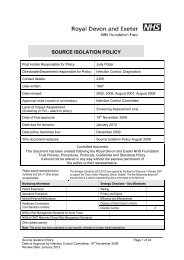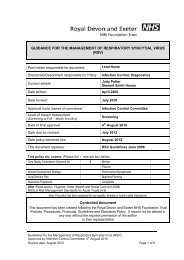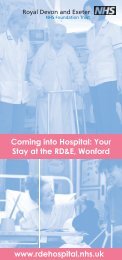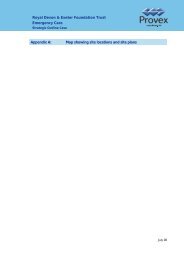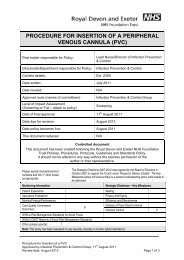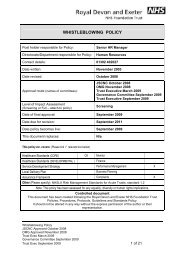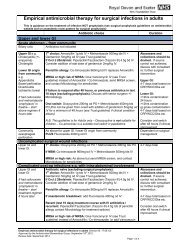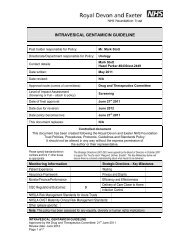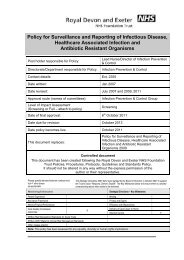Annual Report 2006 - Royal Devon & Exeter Hospital
Annual Report 2006 - Royal Devon & Exeter Hospital
Annual Report 2006 - Royal Devon & Exeter Hospital
You also want an ePaper? Increase the reach of your titles
YUMPU automatically turns print PDFs into web optimized ePapers that Google loves.
Evolving17Senior MatronAnita IrwinThe RD&E is constantly evolving its day-to-dayorganisation, working practices, facilities andservices to improve life for its users and staff and toreflect changes on a wider level.Smoke-free at the RD&EIn the Spring of <strong>2006</strong> we began an awarenesscampaign relating to September <strong>2006</strong> when allbuildings and grounds will become smoke-free,in line with Government directives. In the run-upto this move, a full communication strategy hasbeen set in motion, a smoking cessation officer isavailable to help staff and patients wishing to quitand Nicotine Replacement Therapy has been madeavailable through the hospital shop.Expanded servicesNumerous services have been expanded, includingcardiology, with the opening of a brand new secondcardiac catheterisation lab, a move which comesafter two years of planning and hard work by theproject delivery team. The opening ofa second lab has also made possible acomplete refurbishment of the originallab.The nursing and midwiferyrestructureDuring the year the Trust startedto implement a new nursing andmidwifery structure, in response tofeedback that differences in the roleand range of responsibilities for seniornursing staff varied too much betweendirectorates. This was backed up byan Audit Commission report, so whenthe new pay system Agenda for Changepresented the opportunity to look atthe roles of nurses and midwives at all levels in theTrust, we were keen to consider the possibilities. Therestructure aims to ensure consistency throughoutthe Trust, good career structures and opportunitiesfor staff development. Most importantly, thechanges will help patients to understand who hasresponsibility for their care, as clinical roles aremore clearly defined.Anita Irwin explains what the restructure meansto her. She became a matron in 2001, withresponsibility for ensuring clincial standards,nursing care quality and good teamwork, as well ascleanliness and upkeep of the environment in varioussurgical wards. Initially Anita had reservations “Icompletely understood the principles, but wasn’tsure that a different structure would achieve thechanges we nurses and midwives wanted.”She was soon convinced though:“ I believe we’ve always given excellent care, butonce I got to grips with how the plans would work Ireally appreciated that senior nurses and midwivesneed to step away from the traditional roles we hadin the past. Now, staff with greater experience willspend more time offering support and supervisionto junior colleagues, and use their experience andknowledge effectively to improve patient care.Capital developmentsWork has continued through 2005/06 on Phase 4,our new maternity, gynaecology and neonatologyunit at the main site. The architects have involvedmany clinical staff in the design and layout of thebuilding and staff at the present unit at Heavitreehave been asked to help choose a name for thenew unit.Part of the space left at Heavitree will be occupiedby the <strong>Exeter</strong> arm of the new Peninsula DentalSchool which the Government announced itsbacking for in February <strong>2006</strong>.In February work also began on the new Diabetesand Endocrine Centre, due to open in September.Most of the centre is Trust funded and will providelocal patients with improved care, education,support and research services. Amenities willinclude: eight consulting rooms; dedicatededucational facilities; a focus for clinical trials;a retinal screening hub; diabetes dieticians andfoot service; endocrinology; and the DIRECTcharity office.CASE NOTES: PODSTHE ROLL-OUT OF PODS (PATIENTS’ OWN DRUGSSCHEME) CONTINUES, WHEREBY PATIENTS AREENCOURAGED TO BRING THEIR PRESCRIPTIONSWITH THEM INTO HOSPITALThe Scheme is considered to be good practice bythe Healthcare Commission and Audit Commissionand has many benefits:• facilitates checking of discrepancies betweenmedications mentioned in the GP referralletter and patient testimonial;• patient familiarity with their drugs;• drugs issued by the GP are not wasted andunnecessary Trust prescribing is avoided;• reduced risk of drug administration errors;• saves nurse time for drug administration anddischarge process.”


